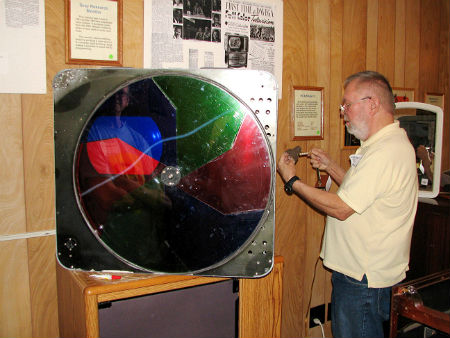Television’s Past Resurfaces at Annual Conference
HILLIARD, OHIO: Once again television history buffs convened in this Columbus, Ohio suburb for the annual Early Television Foundation (ETF) conference, an event which features technical presentations, showing off restored and/or rare television apparatus, buying and selling of antique television-related items, and swapping stories about locating lost television treasures or “the ones that got away.”
“We set another record for attendance,” said Steve McVoy, founder of Hillard’s Early Television Museum and organizer of the ETF conference, “This year, 109 persons were here to take part in the activities.”

Color television enthusiast Cliff Benham touches up the Early Television Museum’s Gray Research CBS field sequential color monitor. (It was designed for 405 line/144 field video.) McVoy noted that the May 4-6 conference marked the 10th anniversary of the convening of television history’s faithful for the purpose of delving into arcane video designs and technology.
THE “CPA” MYSTERY RECEIVER
A very hot item of late has been the discovery and purchase of a very unusual early RCA color receiver on an Internet auction site. The set has been identified as a one-of-a-kind model that was put together during RCA’s early 1950’s “Manhattan Project” to develop a backwardly-compatible color television system. The unearthing of this artifact (which bore no model number and precious little other identification) has lately been the subject of much speculation and comment on a popular collector’s website. The new owner, Nick Williams, was on hand at the conference to present what he has found out about the receiver to an attentive audience.
From what has been determined thus far, the set was likely used in field testing of the color phase alternation (CPA) scheme for ensuring proper color transmission. (CPA was discarded by the second NTSC in establishing U.S. color standards as too costly and difficult due to the requirement for a one-line delay. The principle was later incorporated in the PAL color standard.)
The set probably dates back to 1952 and remarkably, the CRT—a developmental tube—is still under vacuum and has good emission.
Other presentations on “retro TV” included a paper by Dr. George Lemaster on the contributions of the Hazeltine Laboratories to the NTSC color system, a presentation on RCA’s developmental color receivers by Ed Reitan, and a look at color reproduction in television and film by Wayne Bretl.
Several early television artifacts were auctioned, including a Meissner pre-WWII television receiver and two mid-1950s Col-R-Tel filter wheel adapters for displaying NTSC color on a black and white television receiver. According to McVoy, the proceeds from this year’s equipment auction totaled in excess of $10,000. Dates for the 2013 Early Television Foundation conference have not yet been announced.
The professional video industry's #1 source for news, trends and product and tech information. Sign up below.
James E. O’Neal has more than 50 years of experience in the broadcast arena, serving for nearly 37 years as a television broadcast engineer and, following his retirement from that field in 2005, moving into journalism as technology editor for TV Technology for almost the next decade. He continues to provide content for this publication, as well as sister publication Radio World, and others. He authored the chapter on HF shortwave radio for the 11th Edition of the NAB Engineering Handbook, and serves as contributing editor of the IEEE’s Broadcast Technology publication, and as associate editor of the SMPTE Motion Imaging Journal. He is a SMPTE Life Fellow, and a member of the SBE and Life Senior Member of the IEEE.

